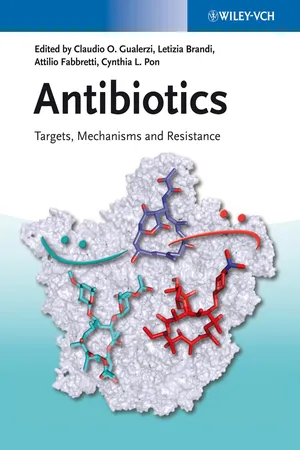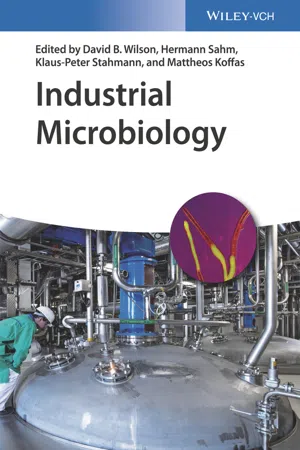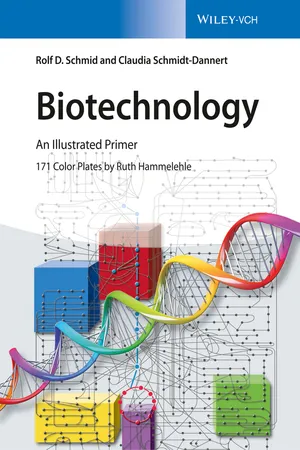Biological Sciences
Classes of Antibiotics
Classes of antibiotics are categorized based on their chemical structure and mechanism of action. Common classes include penicillins, cephalosporins, tetracyclines, macrolides, and fluoroquinolones. Each class targets specific bacterial components or processes, such as cell wall synthesis or protein production, making them effective against different types of bacteria. Understanding these classes is crucial for selecting the most appropriate antibiotic for treating bacterial infections.
Written by Perlego with AI-assistance
Related key terms
4 Key excerpts on "Classes of Antibiotics"
- eBook - ePub
Antibiotics
Targets, Mechanisms and Resistance
- Claudio O. Gualerzi, Letizia Brandi, Attilio Fabbretti, Cynthia L. Pon(Authors)
- 2013(Publication Date)
- Wiley-VCH(Publisher)
Chapter 1
A Chemist's Survey of Different Antibiotic Classes
Sonia Ilaria Maffioli1.1 Introduction
More than 20 novel Classes of Antibiotics were produced between 1930 and 1962. Since then, only four new Classes of Antibiotics were marketed. Interestingly, none of these new classes is really novel: daptomycin, approved in 2000, was discovered in the early 1980s; linezolid, approved in 2000, derives from a synthetic lead discovered in the 1970s; pleuromutilins, approved in 2007, have been widely used for about 30 years in veterinary medicine; fidaxomicin, approved in 2011, was first reported in the 1970s. This chapter reviews the main Classes of Antibiotics in clinical use organized by their chemical structure. For each class, the natural or synthetic origin and a description of the chemical structure are presented. The mechanism of action and spectrum of activity are only briefly indicated as they are discussed more deeply in the subsequent chapters. A short summary of the early structure–activity relationships (SARs) leading to the most known derivatives is described followed by a short overview of the most recent analogous currently under clinical development [1–3].1.2 Aminoglycosides
Aminoglycosides (Figure 1.1 ) were first established as antibiotics in the 1940s and are still widely used worldwide. They are obtained by fermentation of Streptomyces, Micromonospora, and Bacillus; irreversibly inhibit protein synthesis by acting on the ribosome; and are especially active against gram-negative bacteria. They chemically consist of an aminocyclitol substituted with amino sugars. A classification proposed by Umezawa was based on the central structure, which can be streptamine 1, 2-deoxystreptamine 2, or streptidine 3. A relevant number of natural and semisynthetic derivatives have been obtained since their discovery with the aim of bettering the toxicity issues linked to these structures, mainly oto- and nephrotoxicity, and to fight the increased resistance that mostly arises from structural modification of the aminoglycosides by specific enzymes expressed by resistant strains. These studies highlighted the importance of the number and position of the amino groups for the antibacterial activity. For example, the derivatization of the amino and alcoholic groups in kanamycin 4 resulted in an increased potency together with a reduced susceptibility to the inactivating enzymes that act by acetylation of 2′- and 6′-position and by phosphorylation on position 3′. Recently, interest in this class increased again owing to their spectrum of activity and the observed synergistic activity with other antibiotic classes [1]. Among the recent derivatives, plazomicin (ACHN-490) 5 - eBook - ePub
Antibiotics
Challenges, Mechanisms, Opportunities
- Christopher Walsh, Timothy Wencewicz(Authors)
- 2016(Publication Date)
- ASM Press(Publisher)
SECTION II Mechanisms: Antibiotic Action by Bacterial Target Class I n keeping with the central theme of understanding and classifying antibiotics by their mechanisms of action, this section groups antibiotics based on the nature of their bacterial targets. Each of the five chapters takes up a different class of killing targets. Essentially every major class of approved antibiotic, excepting some of the tuberculosis drugs, works against one of these five groups of bacterial targets, illustrating that historically this has been a target-poor therapeutic arena. Chapters 3 and 4 examine the molecular machinery for assembly of bacterial cell walls, with attention to the component reactions that build up and then export and cross-link peptidoglycan (PG) chains. This includes the cytoplasmic phase leading to UDP-muramyl pentapeptide building blocks, transfer to the membrane-linked bactoprenol, and flipping of the disaccharyl pentapeptide from the cytoplasmic to the external face of the cell membrane. The third and final phase involves action of both transglycosylase and transpeptidase enzymes for insertion and subsequent cross-linking of the new PG units. Steps in PG assembly are targets for two major Classes of Antibiotics: the penicillins and cephalosporins of the β-lactam class and the glycopeptides such as vancomycin and teicoplanin. Chapter 5 deals with antibiotics that disrupt integrity of bacterial membranes. These include antimicrobial peptides that are secreted by many types of eukaryotic cells as components of the innate immune response. These act mostly in local microenvironments, and although they have been engineered and optimized for more than 2 decades, they have not yet been commercialized. Molecules in this chapter also include lantibiotics that target the diphosphate linkage in the PG bactoprenol-pentapeptide building blocks - eBook - ePub
- David B. Wilson, Hermann Sahm, Klaus-Peter Stahmann, Mattheos Koffas(Authors)
- 2019(Publication Date)
- Wiley-VCH(Publisher)
Table 8.2 provides a timeline across several compounds identified during the Golden Age of natural product discovery with the addition of more recent compounds, one of which (azithromycin) is a semisynthetic alteration of erythromycin discovered earlier. β‐Lactam antibiotics were the first classification discovered and, as introduced above, showed antibacterial activity. Macrolide antibiotics possess a similar activity profile to β‐lactam compounds and are commonly prescribed as substitutes for patients allergic to penicillin. Aminoglycosides offer an alternative activity profile relative to most β‐lactam and macrolide compounds and are, thus, used to treat a different spectrum of infectious diseases. Tetracycline compounds have shown activity across a broader array of microbial hosts and, as such, this and similar compounds are referred to as “broad spectrum” antibiotics.Table 8.2Antibiotics discovered across decades and natural product classifications.Decade Antibiotic Classification 1920s Penicillin β‐Lactam 1940s Tetracycline Tetracycline 1940s Cephalexin β‐Lactam (cephalosporins) 1950s Erythromycin Macrolide 1960s Tobramycin Aminoglycoside 1970s Imipenem β‐Lactam (carbapenems) 1980s Daptomycin Cyclic lipopeptide 1980s Azithromycin Macrolide As will be described in more detail below, the microbes responsible for infectious disease possess either native or mutation‐based properties that render antibiotic compounds more or less effective. As such, antibiotic compound activity (as surveyed within Figure 8.2 ) is directed at appropriate microbial infectious disease targets. As additional examples, streptomycin is commonly used to treat tuberculosis, whereas daptomycin has shown activity toward the same types of bacteria susceptible to penicillins (termed Gram‐positive bacteria) with activity against an antibiotic resistant form of Staphylococcus aureus (termedmethicillin‐resistant Staphylococcus aureus[MRSA ]). The following sections will now go into more detail regarding the classifications of natural products that have emerged around biosynthetic mechanisms, compound structure, and therapeutic function.8.2 β‐Lactams
8.2.1 History, Effect, and Application
β‐Lactams represent a historic contributor to antibiotic natural product utility. As briefly introduced above, penicillin provided a blueprint for antibiotic natural product discovery and development. The activity of β‐lactams can be traced to the namesake lactam ring and how this disrupts cell wall biosynthesis (Figure 8.1 - eBook - ePub
Biotechnology
An Illustrated Primer
- Rolf D. Schmid, Claudia Schmidt-Dannert, Ruth Hammelehle(Authors)
- 2016(Publication Date)
- Wiley-Blackwell(Publisher)
Occurrence. ~10,000 antibiotics have been isolated from microorganisms, another 10,000 from basidiomycetes and lower fungi, and 10,000 more from higher organisms, especially plants but also lichen and animal and marine invertebrates. Actinomycetes by far outnumber all other organisms in their capacity to synthesize antibiotics.Applications. Only ~300 antibiotics are produced industrially. They are mostly semisynthetic compounds, in which a biologically active lead structure is modified chemically. β-Lactam antibiotics (penicillins and cephalosporins) (→206) make up about half of a world market of >42 billion US$ and some 50,000 t (2009). Most antibiotics are manufactured as antimicrobial agents for chemotherapy. They can be classified as broad-spectrum antibiotics, affecting a wide range of pathogens (e. g., cephalosporins, tetracyclines), and selective antibiotics, used for highly special therapies (e. g., rifampicin against tuberculosis, amphotericin B against fungal infections). Antitumor antibiotics, such as adriamycin, are valuable cytostatic agents, but also exhibit high toxicity. Several antibiotics are used for plant protection. They are often effective in lower concentrations than herbicides and show low toxicity against mammals. Examples are blasticidin S and kasugamycin. Only a few antibiotics are used in food preservation, such as pimaricin, which is sometimes used as an antifungal agent in cheeses. Feed antibiotics lead to a better mast performance and faster growth in mass animal production, but are usually restricted for feed use (e. g., monensin in broiler production), to prevent clinical cross resistance. In molecular biology, antibiotics serve as a research tool for the selective inhibition of various cell functions.Antibiotics: screening, industrial production, and mechanism of action
Screening.
Learn about this page
Index pages curate the most relevant extracts from our library of academic textbooks. They’ve been created using an in-house natural language model (NLM), each adding context and meaning to key research topics.



